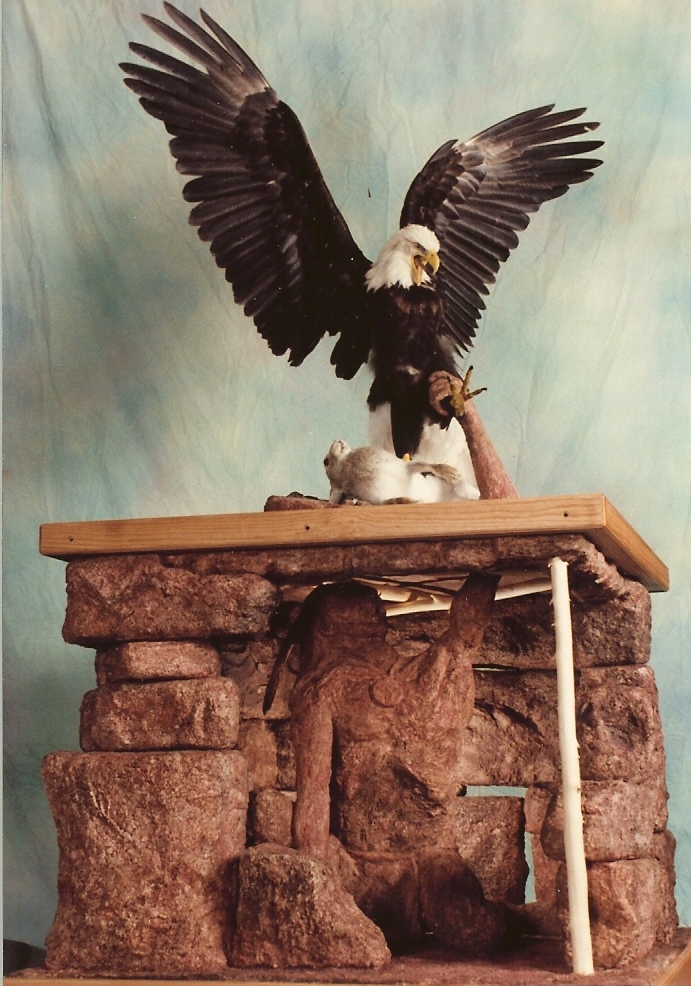As you walk into the Carbon County Museum, most likely the first object you see in the gallery is a taxidermy Bald Eagle swooping in and attacking a poor helpless rabbit.
But if you look closer you will notice something more. A hand is protruding through the ground grabbing the eagle’s taloned leg. It is one of those exhibits with many hidden gems. With careful analysis, it unlocks a fascinating and deeply profound spiritual story.
Lame Deer, a Miniconjou Lakota leader, from the 19th Century, stated that “In an eagle, there is all the wisdom of the world.” The importance of the eagle in many Indigenous cultures in the West is not to be understated.
The eagle itself is considered a portal of wisdom and are viewed as a conduit to the gods or creators, thus the necessity of honoring them. So much so that in some ceremonies, if an eagle feather touches the ground, another ceremony is performed to pick up the feather. Their feathers, talons, and bones adorn weapons, headdresses, clothing, and other trappings of daily life to remind the wearer of their presence and wisdom above all. According to some legends, eating eagle meat is considered blasphemous and the person that consumes this meat will be turned into a monster.
Capturing an eagle is no small task. They are, of course, large birds and can inflict a lot of damage. Additionally, it would be incredibly difficult to sneak up on one and either trap or kill it. These eagle traps are incredibly intricate and require an insane amount of patience and courage. As the display shows, someone will build a stone and wood platform in an area where eagles are prevalent. Bait is laid on the top of the platform, usually, a rabbit that is tied to a post by a strap. There is a hole for the person’s arm to come out and grab the eagle’s leg when it lands to grab the rabbit. The person’s arm shoots through the trap door and grabs the bird’s leg to subdue it. The eagle is then killed and used for ceremonial purposes. It is a fascinating practice steeped in ritual. As stated above all parts of the eagle are used for ceremonial purposes. Not only are the feathers important, but the bones are used for whistles and adornments as well. The Bald Eagle remains an overarching symbol in Indigenous groups throughout the United States.
Due to its importance to Native peoples as well as its symbol of the United States, Bald Eagles are a protected species and are protected from general hunting and capturing.
The Bald and Golden Eagle Protection Act was codified into law in 1940. It “prohibits anyone, without a permit issued by the Secretary of the Interior, from “taking” bald or golden eagles, including their parts (including feathers, nests, or eggs”. It further describes any actions including disturbing, killing, and trapping as Federal offenses. First violations of the act carry fines of $100,000 and one year of imprisonment. Further violations increase fines and jail time and can generate a felony charge for each violation. Even taking a dead eagle is a chargeable offense as they are still protected even in death.
In 1970, the US government established the National Eagle Repository. The National Eagle Repository’s main goal is to preserve dead bald and golden eagles for Indigenous rituals. Many of the eagles that find their way to the repository are eagles that have been killed in accidental situations. These include flying into power lines, car strikes, and even when specimens die while in captivity such as in zoos. Anyone, seeking a permit for a dead eagle to use for religious ceremonies they are asked to apply for a permit from the US Fish and Wildlife Service. Our Bald and Golden Eagle specimens came to us through this program. The bald eagle on display is two eagles in one. The body is of an eagle that had a nervous condition while being rehabilitated. He, unfortunately, plucked all of his feathers out and was unable to be released back into the wild. Its wings are from a different bald eagle. They are from a younger juvenile, who flew into a power conduit and passed away, which is a common way that they are killed in the wild. The talented taxidermist was able to combine both eagles into the beautiful specimen you see today. Aside from the preservation of specimens for exhibition, the program educates people on the importance of the eagle to Native peoples and tribes as well as the conservation of these culturally and biologically important birds.
While ceremonial trapping is all but over, the eagle remains an important part of the fabric of American and Indigenous culture. The Bald and Golden eagles are exclusively found in North America. They have made a staggering comeback from extinction reaching a low of 417 known pairs in 1963. Now through conservation efforts, the Bald Eagle population has exploded to an estimated 316,700 individuals in the wild. The Bald Eagles’ comeback is a remarkable tale of preservation and conservation. While Indigenous Eagle traps are no longer used their impact is still seen throughout the West and the United States. These traps can be seen on the Plains and there are some still to be found on the plains of Carbon County.
--- By Tom Mensik
Sources:
Bald Eagle Protection Act: https://www.fws.gov/law/bald-and-golden-eagle-protection-act
National Eagle Repository: https://www.fws.gov/program/national-eagle-repository/about-us
America's Bald Eagle Population Continues to Soar: https://www.doi.gov/news/americas-bald-eagle-population-continues-soar

